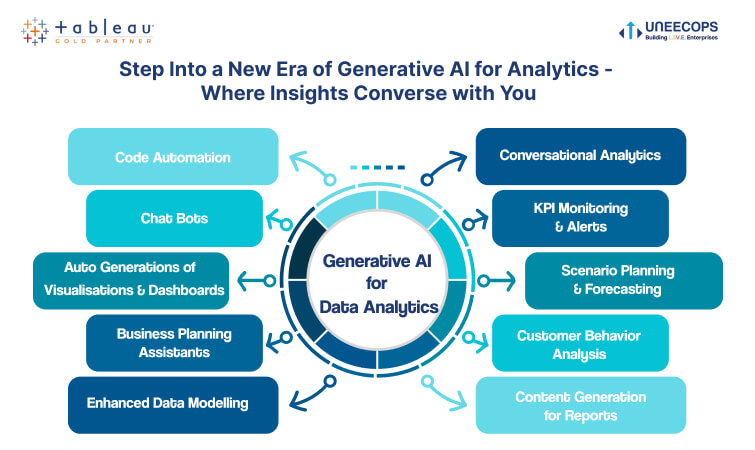Business intelligence has often been used synonymously with data visualization. Data visualization is a core capability of analytical solutions, and as BI processes rely heavily on analytical solutions, it is important to understand how much data visualization can influence a company’s intelligent reporting for better business performance.
Data visualization refers to the practice of presenting information in a graphical manner to communicate data and contextualize it for highlighting important transformations, patterns, and trends. It is often done through a variety of visual formats, such as maps, graphs, plots, and charts in order to make the data easily interpretable.
Correctly used data visualization helps enhance business intelligence outcomes, thus leading companies to better business performances. It helps enterprises draw better conclusions, easily interpret complex data-sets, identify complicated correlations, and quickly make informed decisions.
In this article, we will talk about how data visualization in business intelligence helps enterprises in increasing business performance. Let’s see what’s in store.
Read More:- Why Entrepreneurs are Opting for BI and Analytics Strategies in 2023
What Role Data Visualization Has to Play in Business Intelligence
Business intelligence aims at collecting data and then turning it into actionable insights for fulfilling both strategic and operational objectives. Such insights support decision-making effectively, but to do so, the curated and modelled data needs to be provided to decision makers in a way that it is easily interpretable. Additionally, it must also be understandable by the stakeholders that lack technical expertise, so that they don’t have to be dependent on experts. This is where data visualization in BI steps in. Understand Data Visualization beyond charts and graphs.
In the context of business intelligence, data visualization is one such method that is provided as a self-serving capability of reporting in modern analytics solutions. It enables enterprises to display and share their quantitative data in a manner that is:
- Digestible
- User-friendly
- Data-driven
- Easily-interpretable
With data visualization, day-to-day business metrics and key performance indicators (KPIs) can be delivered interactively to provide deeper context. In every industry, business intelligence is ultimately adopted to break down data for:
- Better understanding of business performances
- Clearer objectives
- Comprehensible potential insights
Data visualization lies at the core of business intelligence to facilitate these functions.
Data Visualization Help Enterprises Increase Business Performance?
Business intelligence represents information through data visualization, which makes it easier to:
1. Read, Interpret, or Understand Data
Data visualization in business intelligence (BI) helps enterprises understand data in several ways:
- Making Complex Data Easy to Comprehend. It presents information in an easy-to-digest format, such as graphs, charts, and maps, making it easier for people to understand complex data. This is especially helpful for non-technical stakeholders who are usually dependent on analysts to understand raw data.
- Better Understanding of Trends and Patterns. It can highlight trends and patterns in data that may not be immediately apparent from raw data, thus enabling informed decision-making.
- Easy Comparison of Data. It helps businesses understand how different data points relate to each other and how they change over time.
- Provides Context for Data and Hidden Patters. Numbers alone can’t easily reveal, and discover hidden patterns in your dashboard. Data visualization provides context for data by displaying relationships and patterns between different data points. It enables easier understanding of the correlation between operations and results.
- See the Bigger Picture and Do Analysis. It allows businesses to analyze data in multiple dimensions to see the bigger picture and draw insights from complex data.
2. Observe trends
Data visualization in business intelligence (BI) helps enterprises observe trends for better business performance by:
- Make Better Decision Making by Identifying Patterns. It allows businesses to quickly identify patterns in data can help businesses make better decisions.
- Find Loopholes and Go for Improvement. It enables businesses to compare the performances of different data points such as metrics, regions, or products to identify trends in loopholes and areas for improvement.
- Visualize Changes How Data is Evolving. It provides a clear and intuitive way to visualize changes in data over time, which helps understand how data is evolving.
- Easy Forecasting of Future Trends. It can be used to create predictive models based on historical data, enabling businesses to forecast future trends.
- Real-Time Monitoring. It can be used to monitor KPIs in real-time so that enterprises can respond quickly to changes in the market by adjusting strategies accordingly.
With data visualization, businesses can make better decisions and enhance their overall performance.
3. Identify the practices that are consistently yielding productive results
Data visualization in business intelligence (BI) helps enterprises identify the practices that are consistently yielding prolific results by:
- Measure Results for Better Outcomes. It allows enterprises to measure the results of different practices or processes so that there is transparency about what is working and what is not.
- Compare Performances of Practices. It enables enterprises to compare the performances of different practices or initiatives to recognize the ones consistently yielding the best results.
- Spotting Trends that Impact Business Performance. It easily spots trends and provides an intuitive way to visualize changes in data over time so that enterprises can understand how different practices are impacting business performance.
4. Detect loopholes and work ways to bridge them
Data visualization in business intelligence (BI) helps enterprises detect loopholes and work ways to bridge them by:
- Identifying Gaps if any. It enables enterprises to easily recognize areas where actual performance varies from expected performance and highlights areas of loopholes or inefficiencies.
- Root Cause Analysis to Get Potential Solutions. Root cause analysis, in simple terms, is a problem-solving method used to detect the root causes of problems. It can be used to perform root cause analysis, allowing enterprises to decipher data for understanding the underlying causes of performance issues and recognizing potential solutions.
Through business intelligence, enterprises can conveniently make informed decisions and ultimately improve business performance. Data visualization in business intelligence (BI) plays a critical role in helping enterprises enhance their business performance by enabling teams to understand complex data easily and draw insights from it effectively. Apart from the ones mentioned above, some other ways in which data visualization can be helpful in business intelligence (BI)are:
1.Improved Decision Making.
Data visualization offers a convenient and intuitive way to present data which enables business leaders to quickly detect trends and patterns in sets of raw data. This allows informed decision-making leading to advanced business outcomes.
2. Enhanced Communication.
Data visualization helps business leaders to communicate data-driven insights clearly and concisely to stakeholders. As a result, it reduces the time and effort required to understand complicated data.
3. Increased Efficiency.
With data visualization, businesses can:
- Detect loopholes and identify ways to bridge them
- Automate routine tasks
- Identify areas for improvement
- Reduce the necessity of manual efforts
As a result, productivity is increased and efficiency is heightened.
4. Better Collaboration.
Data visualization allows teams to work together and collaborate over data-driven insights in order to foster a healthy collaborative environment and increase alignment towards common objectives.
5. Increased Business Agility.
Enterprises can respond quickly to changes in the market by adjusting strategies accordingly with the help of data visualization. As a result, overall business agility is increased and better business outcomes are produced.
All these factors collectively contribute to increased business performance.
Let’s Connect
Effective data visualization offers a different approach to business intelligence, as it shows potential connections along with already existing ones. It leverages the power of attractive visuals to help business leaders see patterns, correlations, and actionable insights outside the norm that can strongly impact the business.
Data visualizations highlight the important and previously unrecognizable patterns to life, giving rise to newly found trends, correlations, and data points. Additionally, it makes data easy to digest and interpret, all of which facilitate exceptional business intelligence.
There are several ways data visualization in business intelligence helps enterprises increase business performance. Although not limited to the points we have mentioned in this article, there are critical ways through which data visualization brings business intelligence to life and helps enterprises enhance their business performances.
Providing a way to visualize the pipeline and measure and monitor performance empowers employees and fuel growth. As changes in the marketplace continue to shape the future of big data, business intelligence, and data visualization, organizations are faced with the challenges of deciding what technologies make the most sense for their operations. Leveraging the right tools could have a significant impact on everything from expense management to operational efficiency, so make sure your company chooses its BI and data visualization tools carefully.
Get in touch with Team Uneecops to assist you with Tableau Solutions for agile decision making!







